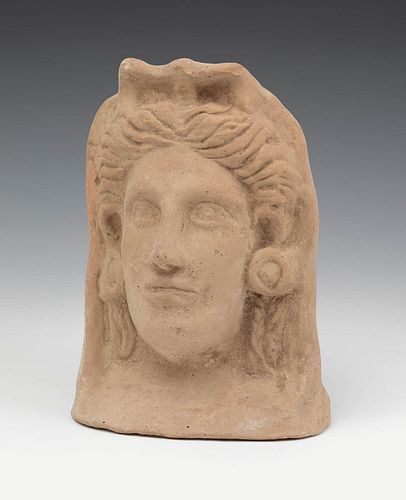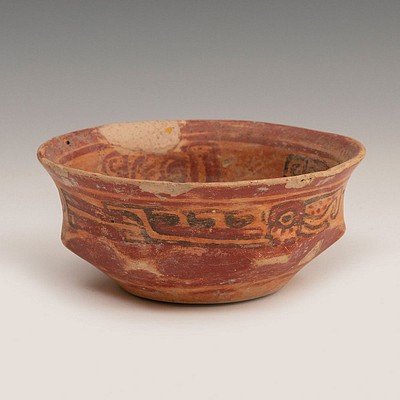Etruscan votive head; 6th-5th century BC. Terracotta.
Lot 12
About Seller
Setdart Auction House
Carrer Aragó 346
Barcelona
Spain
Setdart Subastas was born in 2004 and is currently the first online art auction in Spain with solidity, prestige and reliability guaranteed by our more than 60,000 users. Setdart has a young, dynamic and enterprising team ready to successfully manage the purchase and sale of art works through custom...Read more
Estimate:
EUR€550 - EUR€600
$591.40 - $645.16
Absentee vs Live bid
Two ways to bid:
- Leave a max absentee bid and the platform will bid on your behalf up to your maximum bid during the live auction.
- Bid live during the auction and your bids will be submitted real-time to the auctioneer.
Bid Increments
| Price | Bid Increment |
|---|---|
| EUR€0 | EUR€10 |
| EUR€200 | EUR€25 |
| EUR€500 | EUR€50 |
| EUR€1,000 | EUR€100 |
| EUR€3,000 | EUR€200 |
| EUR€5,000 | EUR€500 |
| EUR€10,000 | EUR€1,000 |
| EUR€20,000 | EUR€2,000 |
| EUR€50,000 | EUR€5,000 |
About Auction
By Setdart Auction House
Dec 23, 2021
Set Reminder
2021-12-23 04:30:00
2021-12-23 04:30:00
America/New_York
Bidsquare
Bidsquare : Archaeology, Session II
https://www.bidsquare.com/auctions/setdart-auction-house/archaeology-session-ii-8051
Setdart Auction House sofia@setdart.com
Setdart Auction House sofia@setdart.com
- Lot Description
Etruscan votive head; 6th-5th century BC. Terracotta. Measurements: 21 x 15 x 11 cm. Feminine head of votive character that shows some idealized feminine features, although with a certain naturalism already, with short hair and open eyes, fixed to the front, maintaining a frontality habitual in some Etruscan works of art and some details that slightly remember Greek works. It is an example of the sculptural art of the Etruscan culture, which already in Antiquity was surrounded by an aura of mystery; even their Greek contemporaries were intrigued by the sudden emergence of this people as a maritime and commercial power, by this ancient people who, according to Dionysius of Halicarnassus, "resembles no other in their language and customs". While there are those who consider them as the people that gave rise to the Roman Empire, there are other experts who give more relevance to the differences that exist between the two peoples and consider them mere neighbors or "conqueror and conquered", depending on the time in which one speaks, recognizing a strong influence of some elements of Etruscan culture and art observed on the Romans. In any case, the Etruscans were great artists and craftsmen, known for what has come down to us from them: profusely decorated and very striking tombs, resembling homes in some cases; terracotta sculptures that, apparently, they polychromed with flat and bright tones (similar to ancient Egyptian works), and used to decorate temples, as sculptures etc.; goldsmithing, pottery, etc.. Etruscan art received from its beginnings an important influence from Greek art, due to the cultural connection existing between both peoples throughout the history of Etruscan culture. This influence was combined with that of Eastern origin and, from the 1st century B.C. onwards, with Roman influence. However, it will be the Asian and Greek tendencies that will determine the development of Etruscan art to the greatest extent. On this basis, an art of its own was shaped, marked by a taste for stylization and lively colors. One of its main sculptural manifestations will be the portrait, which will have mainly a funerary purpose, since in Etruscan culture funeral rites and iconography will play a key role. However, there are also some examples of commemorative portraiture, such as the bronze head of Lucius Junius Brutus (ca. 300 BC), the legendary first consul of the Roman Republic. The Etruscan portrait is not a simple copy of the Greek one, but an original creation combining serenity and passion, a direct ancestor of the Roman portrait.
- Shipping Info
-
In-house shipping available. Please inquire at admin@setdart.com.
-
- Buyer's Premium



 EUR
EUR CAD
CAD AUD
AUD GBP
GBP MXN
MXN HKD
HKD CNY
CNY MYR
MYR SEK
SEK SGD
SGD CHF
CHF THB
THB















